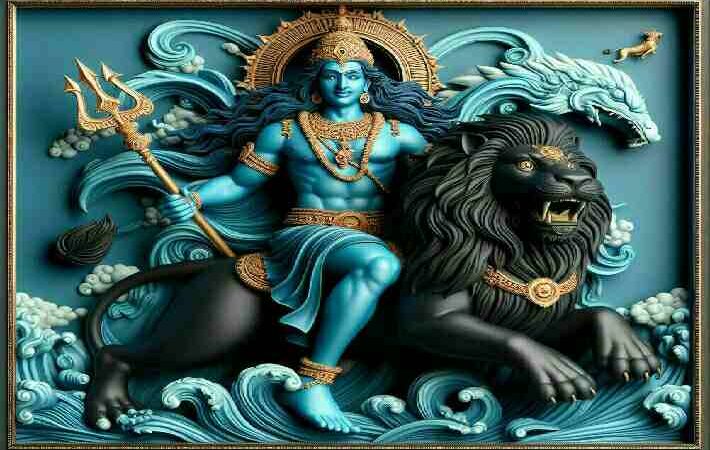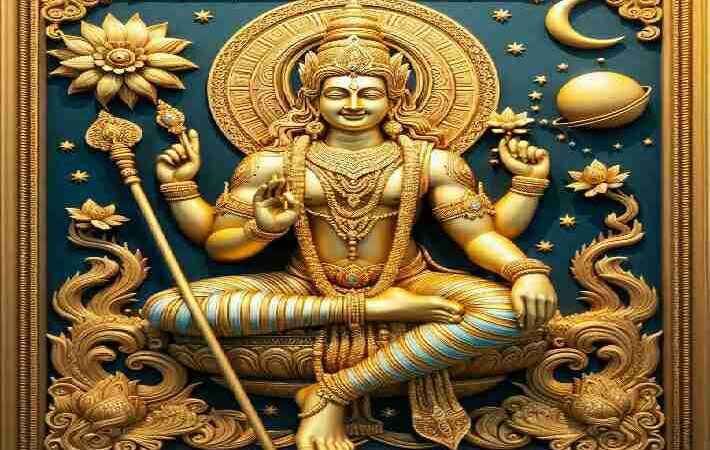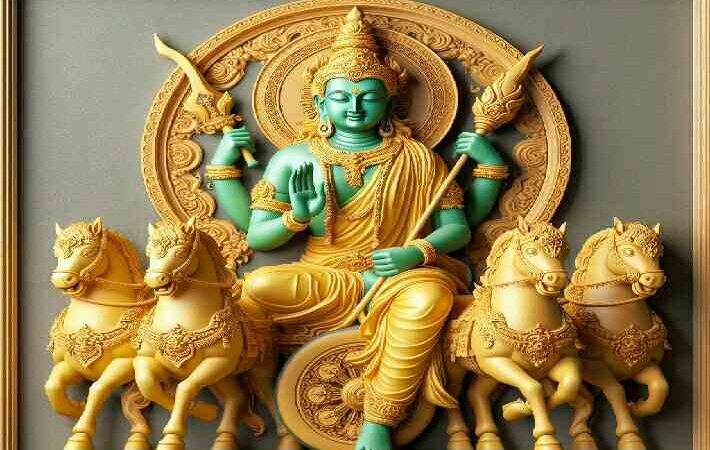Lakshmi-A Hindu Goddess of Prosperity
Goddess Lakshmi
Hindu goddess, Lakshmi or Laxmi is the symbol of good luck. In fact the word Lakshmi is derived from the Sanskrit word ‘Lakshya’ which means ‘aim’ or ‘destination’. Lakshmi is the goddess of wealth, fortune, power, prosperity, luxury, beauty, fertility and auspiciousness. She is the wife of Vishnu (Narayana), one of the Trinity. With Parvati and Saraswati, she also forms holy trinity or Tridevi. Hindu devotees believe that prayer to Laksmmi means prayer for prosperity.

Lakshmi is an ancient Hindu goddess and she possesses six special qualities and 108 names. Her four hands represent the four goals (dharma, kama, artha and moksha) of human life. She is the embodiment of ‘Shree’ or beauty. She personifies wealth, riches, happiness, loveliness, grace, charm and splendour. She stands on a lotus flower. Lotus is a symbol of overall flourishment. There is usually one, or sometimes two elephants behind her, anointing her with water. Her mount, owl symbolizes a yogi who meditates at night when everybody sleeps. Besides, an owl protects our crops by eating mice. So, an owl is also a good omen for our crops.
Goddess Lakshmi in Scriptures
Goddess Lakshmi has a long history testified by the fact that her first hymn, the ShriShukta, was added to the Rig Veda, the oldest and most revered of Hindu scriptures. As per Devi Bhagavat, she is called Swarga Lakshmi in Swarga (Heaven), Raj Lakshmi in Rajgriha (palace) and Griha Lakshmi in Griha (residence). She is Yagna-Vidya, Maha-Vidya, Guhya-Vidya and Atma-Vidya. In Vishnu Puranam, we get this Shri Lakshmi Stuti by Indra –
“Yagna-Vidya Maha-Vidya
Guhya-Vidya Cha Shobhane
Atma-Vidya Cha Devi Twam
Vimukti-Phala-Dayini”
Perhaps the stories of Lakshmi first appeared in the Ramayana and Mahabharata. According to Purana, gods and demons fought over her and both strove to churn her out of the cosmic ocean of milk. So, the ocean can be called the father of Goddess Lakshmi. Again, many precious stones are got in the ocean. These stones are wealth and Lakshmi is the goddess of wealth. So, Lakshmi has a relation with the ocean. As Rama and Krishna are incarnations of Vishnu, their consorts Sita, Radha and Rukmini are identified with Lakshmi. Devi Kamala, Dasham (the tenth) Mahavidya of Dash Mahavidya (ten Mahavidyas or ten aspects of Adi Parashakti) is actually Goddess Lakshmi. According to Swatantra Tantra, she (Devi Kamala) appeared to kill a demon named Kolasura. As per Barahi Tantra, Lord Brahma, Lord Vishnu and Lord Shiva worshipped Devi Kamala. So, she is also called Tripura. Lord Rama and Raja Suratha worshipped actually Maha Lakshmi as a form of Devi Durga.
Different Forms of Goddess Lakshmi
Goddess Lakshmi takes many divine forms. Just as Mother Goddess Durga has nine appellations, Lakshmi manifests in eight different forms. This eight-fold form of Lakshmi is called Ashta-Lakshmi (watch video). It is believed that these eight forms of Lakshmi fulfill the necessities and desires of devotees through their (Ashto-Lakshmi) individual nature. The eight forms of Lakshmi are Adi (primitive)-Lakshmi, Dhana (wealth)-Lakshmi, Dhanya (paddy)-Lakshmi, Gaja (elephant)-Lakshmi, Santana (offspring)-Lakshmi, Veera (strength)-Lakshmi, Vidya (knowledge)-Lakshmi and Vijaya (victory)-Lakshmi. Adi-Lakshmi is the primeval form of Goddess Lakshmi. She is also known as Maha-Lakshmi or the Great Lakshmi. She is regarded as the daughter of sage Bhrigu and consort of Lord Vishnu. Dhana-Lakshmi is the giver of wealth. Dhana means wealth in the form of money or gold. It also means inner strength, talent, virtues, character etc. Thus by the divine grace of Dhana-Lakshmi, her devotees can get all kinds of wealth. Dhanya Lakshmi is worshipped for agricultural wealth (any kind of food grain). She is prayed mainly in agriculture based society. Gaja-Lakshmi was born out of the churning of the cosmic ocean. Gaja means elephant. It is said that Gaja-Lakshmi helped Lord Indra, the king of Heaven, to regain his lost wealth from the depth of the ocean. Santana-Lakshmi is the giver of santana. Santana means offspring. Childless parents worship her for offsprings. Veera-Lakshmi is prayed for strength or power. Actually, the devotees worship her to gain strength and overcome all the sorrows in life. As Vidya means knowledge or education, Vidya-Lakshmi is worshipped for all kinds of knowledge. Vijaya means victory. So the devotees worship her to win in the battle field. Actually, she is worshipped to ensure all around victory in every aspect of life. Lakshmi is also considered a Mother Goddess when it provides wealth in sixteen forms – knowledge, intelligence, strength, valor, beauty, victory, fame, ambition, morality, gold and other wealth, food grains, bliss, happiness, health and longevity and virtuous offspring.
Lakshmi Puja (worship) in Bengal
From the time immemorial goddess Lakshmi is worshipped in Bengal. Kojagori Lakshmi Puja, one of the most popular Bengali Hindu festivals, is celebrated to worship goddess Lakshmi after Durga Puja festival. Kojagori means ‘Ko Jagori’ (who is awake). It is the most auspicious Purnima (full moon) night of the Bengali month Ashwin. Hindu devotees believe that in this night goddess Lakshmi roams to check who is awake and praying to her, and gives her blessings of prosperity. Some Bengal researchers call her a folk goddess. She is very popular among the common folks of Bengal. It is also said that Goddess Lakshmi flows as Padma in Bengal. So, Lakshmi Puja festival is celebrated with religious fervour and traditional gaiety in almost every Hindu home here. Lakshmi is also worshipped along with Lord Ganesha. In some places, she is worshipped on the occasion of Dipavali. On the Ashwin Sankranti (the last day of the Bengali month Ashwin) she is also invoked and worshipped in rural areas of Bengal. Besides, on every Thursday, Sanatan Hindu women worship Goddess Lakshmi.
Important things for Lakshmi Puja
To worship Lakshmi we need some important things. Among them paintings of different types of alpana (motifs) including the bunches of food grains, mudra (currency) and foot prints of goddess Lakshmi, navapatrika or saptatari (a small boat-shaped container made of banana plant) and sorachitra (paintings of Lakshmi image on earthen cover of a pot), Lakshmi panchali (the story of goddess Lakshmi) are very important.
Prayer for Prosoerity
Lakshmi Puja is a common celebration at a Hindu residence. In fact, the women of a Hindu family take part in this celebration. On the occasion of Lakshmi puja the women worship Lakshmi chanting her mantras and reading out her panchali. They pray for prosperity of their family and chant –
om visvarupasya bharjyasi padme padmalaye subhe
sarvatah pahi mam devi mahalaksmi namo-stu te ৷৷
Talker:Krishna Das





